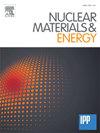Atomic determination of the energetics and configurations of N-Cr/Cr-N-C-O and N-Cr/Ni-vacancy complexes in austenitic Fe alloys
IF 2.3
2区 物理与天体物理
Q1 NUCLEAR SCIENCE & TECHNOLOGY
引用次数: 0
Abstract
The energetics and configurations of small N-Cr/Cr-N-C-O and N-Cr (Ni)-vacancy complexes in austenitic Fe alloys were investigated using a first-principles method. The interaction between N and Cr/vacancy is attractive (0.10/0.59 eV) while Ni/O repels N (−0.21/−0.46 eV). Energetically, interstitial N and Cr can form stable CrmNn complexes, the binding energy of the clusters increases from 0.24 to 2.07 eV with the size (m = 2–16). The tetrahedral Cr4N4 structure acts as a stable unit to form larger size by connecting N (point to point). The presence of Cr strengthens the stability of VNn clusters energetically while Ni weakens it, the Cr-VNn and VNn (n = 1,2) act as main complex defects. Furthermore, we determined the stabilities of serval Cr-N-O/Cr-N-C-O complexes and found that the synergistic interaction of Cr-N-C-O strongly stabilize the clusters and O impurities, then enhancing mechanical properties. Finally, we predicted the effect of Cr/Ni on N migration and effective diffusivity. These results deepen understanding for the synergistic interactions between interstitial N and alloying elements/vacancies in austenitic stainless steels.
奥氏体铁合金中N-Cr/Cr-N-C-O和N-Cr/ ni -空位配合物的能量学和构型的原子测定
用第一性原理方法研究了奥氏体铁合金中N-Cr/Cr-N-C-O和N-Cr (Ni)-空位配合物的能量学和构型。N与Cr/空位的相互作用是吸引的(0.10/0.59 eV),而Ni/O排斥N (- 0.21/ - 0.46 eV)。在能量上,间隙N和Cr可以形成稳定的CrmNn配合物,簇的结合能随着尺寸(m = 2-16)的增大从0.24 eV增加到2.07 eV。四面体Cr4N4结构作为一个稳定的单元,通过连接N(点对点)形成更大的尺寸。Cr的存在有力地增强了VNn团簇的稳定性,而Ni则削弱了VNn团簇的稳定性,Cr-VNn和VNn (n = 1,2)是主要的复杂缺陷。此外,我们测定了几种Cr-N-O/Cr-N-C-O配合物的稳定性,发现Cr-N-C-O的协同作用强有力地稳定了团簇和O杂质,从而提高了机械性能。最后,我们预测了Cr/Ni对N迁移和有效扩散系数的影响。这些结果加深了对奥氏体不锈钢中N与合金元素/空位之间协同作用的理解。
本文章由计算机程序翻译,如有差异,请以英文原文为准。
求助全文
约1分钟内获得全文
求助全文
来源期刊

Nuclear Materials and Energy
Materials Science-Materials Science (miscellaneous)
CiteScore
3.70
自引率
15.40%
发文量
175
审稿时长
20 weeks
期刊介绍:
The open-access journal Nuclear Materials and Energy is devoted to the growing field of research for material application in the production of nuclear energy. Nuclear Materials and Energy publishes original research articles of up to 6 pages in length.
 求助内容:
求助内容: 应助结果提醒方式:
应助结果提醒方式:


